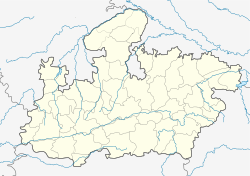Gohad
|
Gohad गोहद Gohud |
|
|---|---|
| city | |
| Location in Madhya Pradesh, India | |
| Coordinates: 26°26′N 78°26′E / 26.43°N 78.44°ECoordinates: 26°26′N 78°26′E / 26.43°N 78.44°E | |
| Country |
|
| State | Madhya Pradesh |
| District | Bhind |
| Elevation | 159 m (522 ft) |
| Population (2001) | |
| • Total | 45,194 |
| Languages | |
| • Official | Hindi |
| Time zone | IST (UTC+5:30) |
Gohad is a city and a municipality in Bhind district in the Indian state of Madhya Pradesh. A town of historical importance it is situated close to the city of Gwalior.It is known as jatwara also.
According to Alexander Cunningham and William Crooke, people of the rajasthan move to village Bamrauli (near Agra) settled the town of Gohad in 1505 and constructed the Gohad Fort.
The historically important rulers among the above were Bhim Singh (1707–1756) and Chhatar Singh (1757–1785). They occupied the Gwalior fort twice; Bhim Singh from 1740 to 1756 and Chhatra Singh from 1780 to 1783. During this period, they constructed several monuments within Gwalior fort, including the Cenotaph of Bhim Singh. In 1783 Gwalior Fort was captured by Marathas under Mahadji Shinde
Gohad was handed over to Marathas under a revised treaty dated 22 November 1805 between Marathas and Britishers. Under this treaty Gohad ruler Rana Kirat Singh was given Dhaulpur, Badi and Rajakheda in exchange with Gohad. Rana Kirat Singh moved to Dhaulpur in December 1805. Sindhias could take over Gohad on 27 February 1806 with the help of Britishers. Thus the Rana Jat rulers of Bamraulia gotra ruled Gohad for 300 years from 1505-1805.
Rana Singhandev II had founded Gohad fort but Maharaja Bhim Singh Rana, Maharaja Chhatra Singh and Maharaja Kirat Singh did the major construction works. The site of Gohad fort was selected strategically on the Vaisli River where it takes a circular turn. The river was dug and flow of river was extended up to the fort to take a semi circular shape. The fort has 7 gates named after the villages to which they face and the way they lead to. These are Itayli (in south), Barthara (in west), Gohadi (in northwest), Birkhari (in northeast), Kathwan (in east), Kharaua (in southeast) and Saraswati. The fort was protected with four lines of defence.
...
Wikipedia

